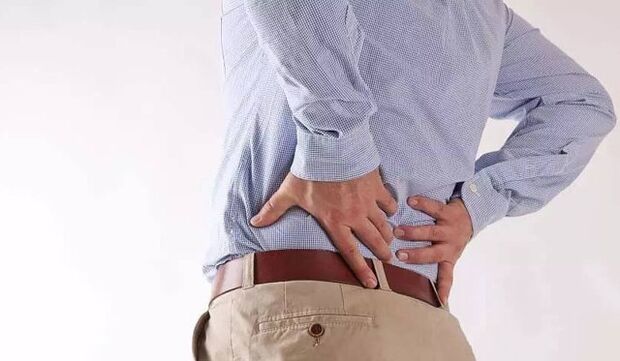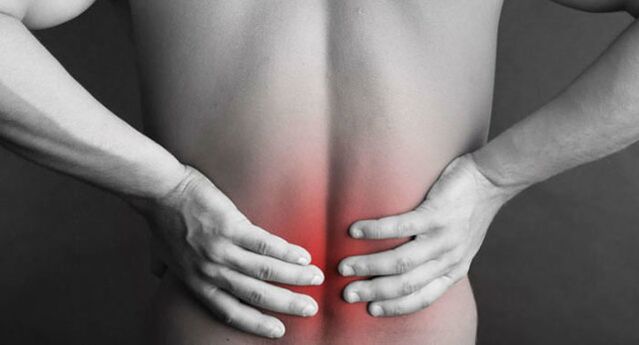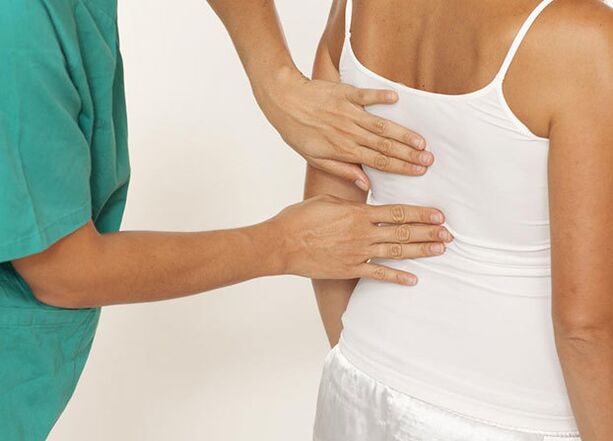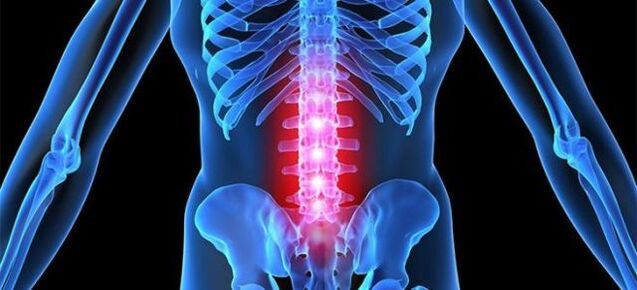About 80% of people older than 55 years of experience the manifestation of different diseases of the rear, should not ignore the people of the younger age categories. Thus, one of the most common spine-osteochondrose diseases lumbar spine - is also located in patients aged 25-45. Even young people aged 16-25 increasingly suffer from symptoms and causes of this extremely unpleasant disease. The question becomes logical about whether it is possible to stop the tendency of patients in general and what is done to each person in preventive needs so that it does not become the victim of this pathology?

Symptoms
With insufficient attention to this disease, the prematurely diagnosis, its treatment is difficult in these secondary diseases or complications. As a natural continuation of pathology, osteochondrosis starts progress. His treatment is not always effective, and in order to store or misrepresented therapeutic course, the risk of disability occurs. Another characteristic problem is the appearance of an intervertebral kille, which is accompanied by unbearable painful sensations. Daily chances of irrevocably solve hernia less and less.
Characteristic clinical symptoms help identify disease in the early stages and avoid these sad consequences:
- Sharp pain after night sleep;
- Pain with sharp spreads of body or raising heavy things;
- The body becomes inactive;
- Scoliosis signs appear;
- The dream becomes restless;
- Depressed moods arise;
- Frequent urination is noticed.
There may be no independent assessment of these symptoms, as most of them have a common similarity with signs of other diseases in spine or joints. Therefore, only a rheumatologist or orthopedic has jurisdiction to discuss the presence of the development of the osteochondrose of the lumbar region.
Classification
Differential diagnosis for proper disposal of the disease to distinguish it from identical pathology and determine the treatment course, the classification of the phases of this disease helps:
- Phase 1 - At this point, the cartilage structure is just beginning to change. But now pathological processes of nerve endings roots are affected. As a result, the pain is given in your legs. At the same time, blood flow and inflammation is born. Pain is acute or stupid, and appear mainly only after reinforced loads on the axis of the back;
- The second phase begins with the destruction of the fibrous ring in the spine, while the cartilage is thanja, and vertebrates reduce the distance to each other. The pain in the second phase is sharp and sharp, sometimes unreasonable. In this period, the mobility of the spine appears throughout their axis, nerve rings, pressing on the soft tissues of the muscular corset;
- Phase 3 is characterized by a strong compression of muscle fibers and nickels. Unbearable cramps and pain with burning from worse. In the area of defeat is a feeling stiffness. With intensive disease development, signs of paresis and paralysis occur;
- Stage 4 - a period of growth of already formed osteophytes (neoplasms with bone structure). At this stage, changes in degenerative nature are activated, arthrosis in spine and joints appear. It becomes inactive on the back and in the absence of proper treatment - completely motionless.
Diagnostic methods
Since even the ideal knowledge of the clinic and classification of the lumbar spine does not give a complete idea of pathological processes that do not implement it, a doctor who deals with pathological processes in the spine, place the muscle-bony system or orthopedic overview:
- X -Ray on the frontal and side projection - enables the identification of axis, osteophyte formation, the anatomical abnormalities of vertebral;
- Magnetic resonance - determines the state of the entire background zone on the back, reveals fragments of destroyed vertebrae, cartilage and hotspot inflammation;
- The calculated tomography gives the idea of the state of soft tissues, bones of vertebrae, the outer shell of the intervertebral disk, in principle, which is in principle for its integrity. and circulation of blood in the field of disease localization.

At the same time, the patient takes tests for rheumatoid test, general blood indicators, content of biochemical components. The overall results of the survey allow you to do exactly the diagnosis and identify the development phase of the osteochondrose of the lumbar region.
Symptoms and treatment of osteochondrose lumbar spine
Among the usual causes of pain in the back of the back, osteochondrose of lumbar spine, symptoms, whose treatment has its own characteristic characteristics. The disease is the starting phase of osteochondrose associated with the process of destroying cartilage rings, interverters, changes in their height towards reducing, forming swelling and fastening nerve roots. Young and older people can face disease, regardless of sex, social status and religion. The long absence of the event symptoms leads to loss of precious time and transition from one stage of the disease in the heavier forms of their development. The main characteristic of osteochondrose is the border zone of dystrophic changes in the tissues of the vertebrae, which does not exceed joint cartilage.
Causes of the initial stage of osteochondrose
Numerous external and internal factors determine the development of the pathological condition of the lumbar region of the axial skeleton. Lumbars Osteochondrosis appears due to certain risk factors. They include:
- Body aging after 50 years;
- Improper posture and anomalies of the anatomical structure of the axial skeleton, which determines the uneven burden on the vertebral;
- Lifting weight with a weak muscle frame;
- the hypothermia of the patient's body in the whole and lower back separately;
- DISFUNCTION OF METABOLIC PROCESS, WORKING OF ENDOCRIAN ORGANIES, CARDIOVASCULAR SYSTEM;
- Uneven spine load during the performance of production duties, households, professional and amateur sports;
- pathologies of the musculos-bone system of innate or acquired nature;
- Hypodynamia, high frequency of stressful situations;
- surplus body weight of the patient;
- Lack of vitamins, minerals, trace elements in the body of the sick person, which are responsible for the health of the spine;
- Procurement of high shoes, unpleasant platforms;
- Use of high pillows and soft mattresses during rest and sleep.
The frequency of the diagnosis of the osteochondrose of the lumbar skeleton is determined by the number of risk factors for its development that are present in the patient's life.
Diagnosis of the disease
Determining the degenerative-dystrophic lesion of one of the five vertebrae of the Lumbar Axial Society space provides for diagnostic measures. Prescribe them a doctor. At the consultation with a specialist who knows how decugal osteochondrose, the history of the disease is collected, time and characteristics of signs of signs, the intensity and place of local sensations are clarified. The state of muscular fibers in the damage zone is determined by visual examination. The use of the palpation method provides an opportunity for a doctor to see a picture of the vertebrae symmetry and distance between them. The final diagnosis is established after obtaining the results of additional studies. They include:

- X -ray, performed in two projections and providing opportunities to see the position of vertebrae, disk height, seal of marginal bones and growth;
- Recording magnetic resonance imaging, which is a special research method for determining the condition of the vascular system and fibrous rings in the degenerative-dystrophic lesion zone.
Goals and methods of treatment of pathology
The results of diagnostic measures are the basis for treatment regime for osteochondrose of the lumbar lumbar skeleton, which follows certain goals. They include:
- reduction in pain intensity caused by degenerative-dystrophin lesions of one or more vertebral skeletons;
- Normalization of metabolic processes in cartilage, their reconstruction and exclusion of risks from their further destruction;
- Reduction of loads on nerve fibers;
- Increased blood flow in spine tissues using massage, physiotherapy procedures;
- Strengthening the muscle framework of the axial skeleton regular exercise exercises of the therapy recommended by the instructor.
Chondroze therapy lumbar spine, symptoms and treatment that have its own characteristics, consists of taking and using drugs, traditional medicine recipes, methods of unconventional treatment, including hyrudootherapy. The effective addition to solving the problem of pathology is physiotherapy, water, massage procedures, gymnastics and sports, including special exercises. Therapy drugs involve the use of antistery non-unintal non-asterical medications, muscle relaxants, hondroprotectors, vitamin complexes with elements and minerals.
In addition to very difficult pain, the newly identifieds or lodocaine blockages were prescribed, executed by introducing injections to the affected places of vertebrae. For local use, fats, gels, cream, heating patch, anti-coal effect prescribe. Physiotherapy treatment includes the passage of electrophoresis courses, at least normal currents, ultraviolet exposure, manual, striking wave and reflexological procedures. In the absence of positive dynamics, the appearance of the hernital protrusions is prescribed, surgical operation is prescribed. To avoid developing complications by the appearance of the first symptoms, the treatment must begin immediately.
Lumbar Osteochondrosis
Lumbar osteochondrose is one of the most common forms of a fundamental disease, actually osteochondrose. Lumbar osteochondrosis, whose symptoms that are equally determined by men and women, in the form of pain concentrated in the area of the Cross Mirror, reflected in their symptoms and on the lower extremities, which are often determined as "pushing the lumbar nerve".
Lumbar osteochondrose protrusion
It passes in this area of interest to us are most often developed, including these are protruding that causes the appearance of pain in the lower back. The lumbar region itself, given its location and characteristics, is the most subject to the appearance of certain functional problems. That is, when considering this statement on the one hand, may differ that our center of gravity relates to the Lumbary Department directly, it is a significant part of the account. During consideration, on the other hand, it may be noted that significant amplitude movements, again, falls on this lumbar region. Given this, the maximum tendency of damage (as well as the occupation protrusions for us) on the discs is concentrated in the lumbar area. In addition, we must not forget that the disk changes are happening in this and, of course, in other areas, including in the background of age - residential degenerative processes.
Let us remind our readers who are the protrusions themselves. Connecting discs with each other in the spine provides the cartridges based on cartilage. The main components of the intervertebral disk are the core jet and fibrous ring, through which the fixation is provided within the spinal disk. The impact of certain factors and conditions is caused by the possibility of breaking this ring, based on the background, which is stated, the core protrusion appears. As a result of this hernia process, it develops. As for the protrusion, it is already being developed as a result of a similar process stream, but without a simultaneous ring rupture - in this case it is simply subject to thinning, not a break, because the core is closely through the ring. In fact, this protuberance is defined as a protrusion.
As for the symptoms of the protrusion, it is manifested as follows:
- a feeling of numbness in the lower back;
- Painfulness in the lumbar area;
- Lower pain of chronic nature;
- Lumbusaclali radiculite;
- Armeness, pain, finger thru on their feet, in their feet;
- Founded urination functions (in rare cases of pathology under consideration).

Mostly conservative treatment applies to the lumbal disk protrusion. Meanwhile, significantly in the development of the protrusion often accompany heavy symptoms, treatment resistant, in this case, you can no longer work without surgical intervention.
Treatment
Mostly osteochondrose treatment is multicomponent and quite complicated in their implementation. Mainly all measures of therapy are reduced to the following points:
- medication treatment;
- If necessary - surgical treatment;
- diet;
- Medical physical education.
Deterioration of the disease requires, primarily compliance with patients beds. The main recommendation for this part is a hard / hard place to sleep. Extremely expressed in manifestations, attacks provide the need for minimal motor load and in early contact with the relevant expert.






















